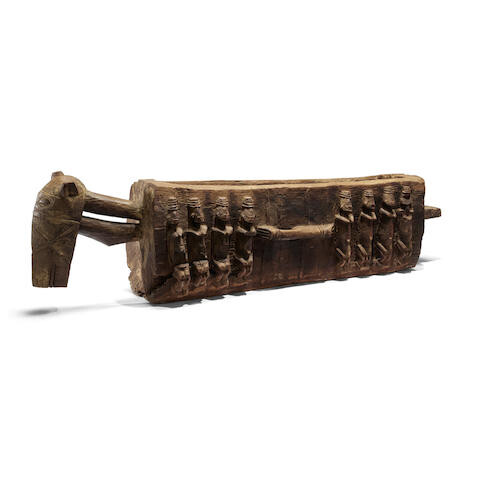Important and Rare Dogon Anthropomorphic Container, Mali
aduna kor
length 73 3/4in (187.3cm)
Provenance
Cornette de Saint-Cyr, Paris, 13 March 1981, Lot 13
Galerie Hélène and Philippe Leloup, Paris
American Private Collection, acquired from the above in 1991
Published
Leloup, Hélène, Dogon, Musée du Quai Branly, Paris, 2001, pp. 304-305, no. 63
Leloup, Hélène, Dogon Statuary, Daniele Amex, Strasbourg, 1994, p. 501
Exhibited
Paris, Musée du Quai Branly, Dogon, 4 April - 24 July 2011 / Bonne, Kunst und Ausstellungshalle, 14 October 2011 - 22 January 2012
'These containers (according to Kate Ezra), some of which are over six feet long, are kept in each lineage head's house, ginna, and are used to hold the raw and cooked meat of sheep and goats that are sacrificed to the family's altars dedicated to Amma, the Creator, and the family's own ancestors, vageu, at the annual ritual known as goru. Performed in each ginna at the time of the winter solstice, goru, which also means humidity, richness, and abundance, is the culmination of the rituals that celebrate the millet harvest, which will sustain the family for the coming year.
Containers with horse's heads, as well as many other wooden vessels and slit drums, have been interpreted as representations of the mythic ark that descended from heaven to reorganize and populate the world. The ark sent by Amma, the Creator, was guided by Nommo, the primordial being who monitors purity and order in the universe. In addition to the eight original ancestors of mankind, the ark also contained everything that would be essential to life on earth. When the ark landed on the earth, Nommo was transformed initially in a horse that pulled the ark along a zigzag course to water, and later into the fishlike form by which he is known and worshipped as the "Master of Water."
The container's boxlike shape and the horse's head and tail may suggest the ark pulled by Nommo in horse form. . . . most such containers portray human figures interpreted as the ancestors who traveled to earth in the ark.' (Ezra, Kate, Art of the Dogon, The Metropolitan Museum of Art, New York, 1988, pp. 100-101)
Of extremely hard wood and profound scale, the horse's head extends out from the front of the rectangular container with two parallel necks, the lower with a laryngeal prominence, the head with carved reins and a mouth defined with serrated upper and lower teeth; the container deeply carved on the interior with two groupings of four ancestral figures on each outer side; a rectangular plank extending at the back as a tail; varied light and dark brown patina on outside surfaces, blackened patina on the interior, wear overall indicative of significant age and cultural use.
View it on
Estimate
Time, Location
Auction House
aduna kor
length 73 3/4in (187.3cm)
Provenance
Cornette de Saint-Cyr, Paris, 13 March 1981, Lot 13
Galerie Hélène and Philippe Leloup, Paris
American Private Collection, acquired from the above in 1991
Published
Leloup, Hélène, Dogon, Musée du Quai Branly, Paris, 2001, pp. 304-305, no. 63
Leloup, Hélène, Dogon Statuary, Daniele Amex, Strasbourg, 1994, p. 501
Exhibited
Paris, Musée du Quai Branly, Dogon, 4 April - 24 July 2011 / Bonne, Kunst und Ausstellungshalle, 14 October 2011 - 22 January 2012
'These containers (according to Kate Ezra), some of which are over six feet long, are kept in each lineage head's house, ginna, and are used to hold the raw and cooked meat of sheep and goats that are sacrificed to the family's altars dedicated to Amma, the Creator, and the family's own ancestors, vageu, at the annual ritual known as goru. Performed in each ginna at the time of the winter solstice, goru, which also means humidity, richness, and abundance, is the culmination of the rituals that celebrate the millet harvest, which will sustain the family for the coming year.
Containers with horse's heads, as well as many other wooden vessels and slit drums, have been interpreted as representations of the mythic ark that descended from heaven to reorganize and populate the world. The ark sent by Amma, the Creator, was guided by Nommo, the primordial being who monitors purity and order in the universe. In addition to the eight original ancestors of mankind, the ark also contained everything that would be essential to life on earth. When the ark landed on the earth, Nommo was transformed initially in a horse that pulled the ark along a zigzag course to water, and later into the fishlike form by which he is known and worshipped as the "Master of Water."
The container's boxlike shape and the horse's head and tail may suggest the ark pulled by Nommo in horse form. . . . most such containers portray human figures interpreted as the ancestors who traveled to earth in the ark.' (Ezra, Kate, Art of the Dogon, The Metropolitan Museum of Art, New York, 1988, pp. 100-101)
Of extremely hard wood and profound scale, the horse's head extends out from the front of the rectangular container with two parallel necks, the lower with a laryngeal prominence, the head with carved reins and a mouth defined with serrated upper and lower teeth; the container deeply carved on the interior with two groupings of four ancestral figures on each outer side; a rectangular plank extending at the back as a tail; varied light and dark brown patina on outside surfaces, blackened patina on the interior, wear overall indicative of significant age and cultural use.



